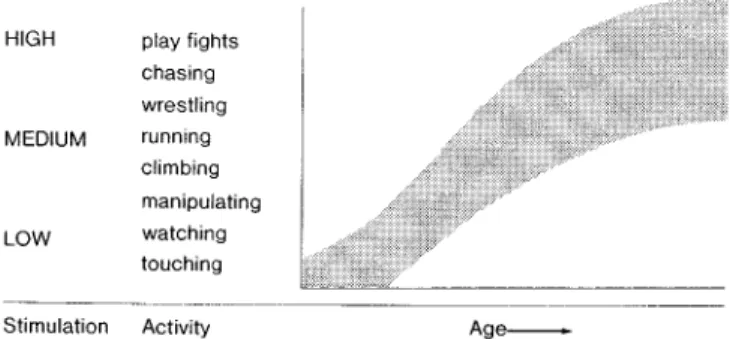THE BEHAVIORAL AND BRAIN SCIENCES (1978), 2,173-213
Printed in the United States of America
The stage question in
cognitive-developmental theory
Charles J. Bralnerd
Department of Psychology, The University of Western Ontario, London, Ontario,
Canada N6A 5C2
Abstract: The term "stage" appears to be used in three general senses in theories of behavioral development: (a) as a metaphor: (b) as a
description of behaviors that undergo age change; (c) as an explanation of age-related changes in behavior. Although most existing
stage models are purely descriptive, a few of them purport to have explanatory power. One such model, Piaget's stages of cognitive
development, is considered in this paper.
To be viewed as potentially explanatory, a stage model must describe some behaviors that undergo age change, posit antecedent
variables believed to cause the changes, and provide procedures whereby the behavioral changes and the antecedent variables can be
independently measured. Piaget's stages seem to satisfy some but not all of these requirements. Piaget's stages describe many
age-related changes in behavior, and some antecedent variables have been proposed. However, procedures do not exist for measuring the
two factors independently. In lieu of such procedures, Piaget has outlined a "program" of five empirical criteria whereby the reality of
his stages can ostensibly be verified. Some objections to these criteria are considered.
The five criteria in Piaget's program are invariant sequence, cognitive structure, integration, consolidation, and equilibration. Three
of the criteria (invariant sequence, integration, and consolidation) lead to the same sorts of empirical predictions (culturally universal
sequences in the acquisition of certain behaviors). Such predictions are subject to the objection that Piagetian invariant sequences are
often measurement sequences. A measurement sequence is said to occur when some late-appearing behavior consists of some
earlier-appearing behavior plus additional things. The cognitive structure criterion is subject to at least three criticisms: First, it yields, at
most, descriptions of behavior; second, these are often nothing more than descriptions of task structure; third, they cannot be regarded
as unique to the given stages for which they are posited. The fifth criterion, equilibration, generates some predictions that might be
considered as prima facie evidence for the existence of stages. However, these predictions conflict with the current data base on
Piaget's stages.
It is concluded that there is no compelling support for Piaget's hypothesis that his cognitive stages do more than describe age-related
changes in behavior. Since explanatory statements involving stages appear with some regularity in Piagetian and neo-Piagetian
writ-ings, there are grounds for supposing this conclusion to be nontrivial.
Keywords: cognitive development, cognitive structure, developmental stages, invariant sequences, Piagetian theory.
The aim of this paper is to generate discussion on a topic that,
has seemingly been frozen in cross section for the past several
years: In what sense or senses is it meaningful to speak of
"stages" of cognitive development? My approach is to pose this
question with reference to the preeminent stage theory of our
time, Piaget's (e.g., 1950, 1970a; Piaget & Inhelder, 1969).
Though it will take some space to develop, my basic line of
argu-ment is quite simple. Whereas Piaget's stages are perfectly
ac-ceptable as descriptions of behavior, they have no status as
explanatory constructs. This will, no doubt, seem a thoroughly
unremarkable claim to many readers. But it leads to an
interest-ing conclusion. Statements to the effect that children do or do not
do such and such because they are at some given stage of
cogni-tive development are meaningless - or, more precisely, they are
circular. Since statements of this sort are often made both in
Ge-nevan writings and in neo-Piagetian theorizing, this conclusion
would seem to be nontrivial.
At present, stage model-building a la Piaget is a popular
pas-time in the literature on human cognitive development. I
some-times have the subjective impression that the density of such
models in developmental journals must average about one per
issue. For this reason, it would be rash to hope that many readers
will be favorably disposed toward the arguments presented
below or will be inclined to accept my conclusions. However,
the ultimate fate of these arguments and conclusions is
unim-portant. This paper will have more than served its purpose if it
acts like something of a Rorschach stimulus in reawakening
dis-cussion of the stage question and prompting other writers to
formulate new proposals about how to identify discrete changes
in cognitive development.
General desiderata
One may distinguish three general uses of the stage construct in
theories of behavioral development: aesthetic, descriptive, and
explanatory. In the first case, stages are ideals that do not
necessarily refer to anything definite or measurable in
develop-ment. The term "stage" is used metaphorically because it tends
to evoke certain images in readers. It is common to cite Erikson's
(1950) theory of psychosexual development as an example of this
use of stages. But G. Stanley Hall's model of mental
develop-ment, with its allusions to sociocultural evolution, would do just
as well. Among more recent theories, a case could be made for
the conclusion that Kohlberg's (e.g., 1963, 1968) stages of moral
development are primarily aesthetic. Kohlberg diagnoses these
stages with a projective technique called the Moral Judgment
Scale. However, the diagnosis for any given child is not intended
to imply that certain moral behaviors will be observed in that
child (Kurtines & Greif, 1974). Also, the model apparently does
